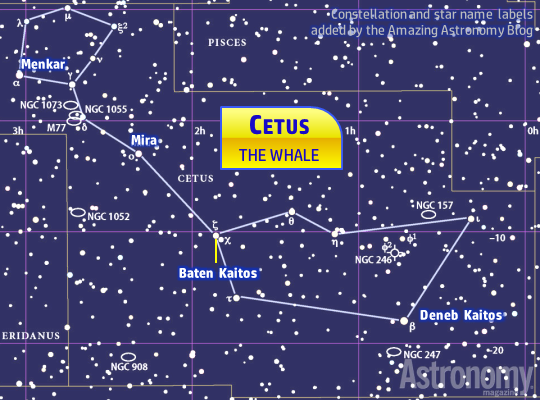Tuesday, July 16, 2013
Cetus
A large constellation for sure, CETUS the Whale (or Sea Monster) can be spotted from both the Northern and Southern Hemispheres on Earth. In the sky, Cetus is found north of the constellations Fornax and Sculptor, south of Aries and Pisces, southeast of Taurus, east of Eridanus, and west of Aquarius. Use a very bright constellation, Orion, as a reference to find Cetus, which is located east of Orion (you would cross a northern section of Eridanus before finding Cetus). Cetus is not very bright, but it does contain an assortment of galaxies and planetary nebulae. Two notable galaxies are M77 and NGC 246 (nicknamed the Pacman Nebula), and several other examples of galaxies categorized in the New General Catalogue (NGC) include NGC 247, 428, 936, 1042, and 1052, among others. The brightest star is usually the alpha star (designated with an α symbol), but the beta star (β) in Cetus is actually the brightest! The brightest star is Deneb Kaitos with a magnitude of around 2.02, while the second bright star is Menkar with a magnitude of 2.53.
Subscribe to:
Post Comments (Atom)
Blog Background
The background has three Hubble Space Telescope images:
— LH 95 is a star-forming region in the Large Magellanic Cloud, Dorado constellation.
— Ant Nebula (also called Menzel 3) is an aptly-named planetary nebula located in the constellation Norma.
— Egg Nebula (also called CL 2688) is a protoplanetary nebula in the constellation Cygnus.
— LH 95 is a star-forming region in the Large Magellanic Cloud, Dorado constellation.
— Ant Nebula (also called Menzel 3) is an aptly-named planetary nebula located in the constellation Norma.
— Egg Nebula (also called CL 2688) is a protoplanetary nebula in the constellation Cygnus.


No comments - Post Comment Here
Post a Comment